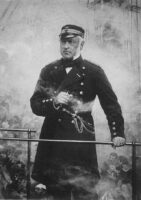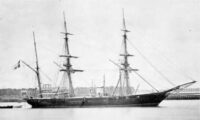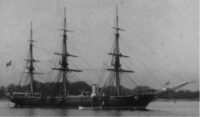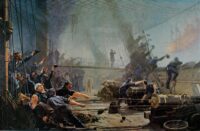During the rebel War in 1848-1850, Denmark had established a very effective blockade of the German North Sea ports, and this seemed to succeed again in 1864.
At the outbreak of the war in February, a blockade of the German North Sea ports again began. Denmark had always been one of the largest maritime nations in the region and had at that time the world’s 6th largest fleet.
Austria had the 7th largest and Prussia nothing of importance.
A repetition of the successful blockade of German ports was therefore an obvious opportunity to put pressure on Prussia.
Already from the end of January the screw frigate Niels Juel had stayed in Skagerak to observe 3 Prussian cannon boats possibly in that part of the North Sea.
At the outbreak of the war on 1 February, the chief, War Captain Johan L. Gottlieb, was ordered to relocate south to the area between Borkum and Helgoland. Shortly thereafter, the operating area towards Falmouth was expanded in the English Channel. The task was still to observe the three cannon boats, but now also to bring up any German merchant ship you might encounter.
This presence frightened the German shipping companies as the danger of bringing up was imminent.
Due to the harsh weather of the season, Niels Juel had to return to Copenhagen for repairs and was replaced by the screw corvette Dagmar, March 18 Dagmar arrested the schooner “Tekla Schmidt” of Hamburg on the island of Texel off the North Holland coast.
At the beginning of March 1864, the Naval Ministry finds that Austria, together with smaller Prussian units, is sending a naval force against the area in order to break the effective Danish blockade.
Therefore, it was decided to multiply a North Sea squadron consisting of Dagmar already in the area as well as the Niels Juel screw frigate and the screw corvette Hejmdal.
The last two were in Copenhagen at the time. Chief of Squadron became War Captain Edouard Suenson.
He was very experienced with several minor battles during war 1848-50.
He had served in the French Mediterranean fleet in the 1830s.
A few hours after the two warships had left Copenhagen, the Naval Ministry received telegraphic reports that the Austrian frigate Radetzky had left Gibraltar heading north.
On April 8, the two Danish warships call Kristianssand, and continue into the North Sea. On April 11, they meet with Dagmar, and Suenson’s squadron is now assembled.
There were no enemy ships in sight, with constant telegrams on their movements from Gibraltar to the north. While awaiting the enemy vessels, the blockade made by the German had now become so effective that the German shipping companies began pro-fling their ships so that they now sailed under the Russian flag.
On April 19 in the afternoon, two Austrian frigates had left Brest and expected the Austrian battleship “Kaiser” the following week. Dagmar was at this time heading west toward Texel. Suenson feared that Dagmar should run into the two frigates and therefore pursued Dagmar.
On the way, he met the squadron’s third unit, Hejmdal, who had to give up a German prize for instead, together with Niels Juel, to reach Dagmar and get the squadron together. They obtained Dagmar off the coast of Den Helder on the Dutch coast, and together the ships returned to Helgoland.
The captain of the Dagmar was able to report that in Nieuwediep he had observed the three Prussian ships that he had been looking for since January, the cannon boats Blitz and Basilisk as well as the wheel steamship Preussischer Adler.
Via a private telegram, they had been notified that Dybbøl had been taken by the Prussians, and they were now in doubt as to whether the Naval Ministry was able to contact the squadron at all.
At the same time, it was wondered if there was more use for the ships in the defense of the Danish belts and the Baltic.
The lack of intelligence and the sparse, some directly contradictory informations , prompted Suenson to summon the ship’s chiefs to a war council aboard Niels Juel. Here it is decided to submit to Kristianssand in order to obtain reliable contact with the Naval Ministry and from here they would have a good starting point to either solve the offensive task in the North Sea, or any defensive task in the belts and the Baltic.
April 23rd in the morning the squadron arrives at Kristianssand. First and foremost, telegraphic contact was sought for the Naval Ministry, and then refueling began on the vessels’ magazines, not least coal, so that they were ready for immediate departure.
In the Naval ministry, they were disappointed that the squadron they believed to be located at Helgoland was anchored in Kristianssand and that the quality of the intelligence received was so poor. Suenson could be informed, that the two Austrian frigates were still in Brest and that the Austrian squadron there, among other things. included the liner Kaiser, still lying around Lisbon.
At the same time, the ministry announced that the screw frigate Jutland would be sent up to reinforce the squadron and that Dagmar should resign when Jutland arrived.
Until this time, the squadron was to patrol a line of Kristianssand – Hanstholm.
War Captain Suenson’s North Sea Squadron until April 28:
The Screw frigate “Niels Juel” 42 guns 422 men
The screw frigate “Jutland” 44 guns 437 men
The screw corvette “Hejmdal” 14 pcs. 18 pound guns 260 man
The screw corvette “Dagmar” (Departing April 28) 16 pcs. 30 pound guns 150 man
Dagmar departed from the squadron while expanding the operation area to the south and it is stated that the two Austrian frigates have left Brest but remained in the English Channel.
April 30, it is stated that the frigates were now with Dover. May 4 the squadron is again in Kristianssand to receive new supplies and at the same time arrives Jutland, which brings order to the squadron to sail to the Bay of the Helgoland to meet the hostile warships.
The Danish squadron should depart on May 6th.
At the same time, it is confirmed from several sides, that the two Austrian frigates had arrived to the waters and had united with the three Prussian cannon boats at Texel off the north coast of Holland.
Captain Tegetthoff’s Austro-Prussian Squadron:
The frigate “Schwarzenberg” (Austria) 51 guns 498 men
The frigate “Radetzky” (Austria) 37 guns 372 men
The cannon boat “Preussicher Adler” (Prussia) 4 guns 110 men
The cannon boat “Blitz” (Prussia) 3 guns 66 man
The cannon boat “Basilisk” (Prussia) 3 guns 66 men
On the way to Helgoland, May 7, Hejmdal’s boiler begins to leak. The squadron is quiet for 12 hours before Hejmdal’s crew manages to repair the boiler. and they arrive in the Bay of the Helgoland on May 8th.
After reconnaissance in the waters on May 9th, the Austrian squadron was informed upon arrival at Cuxhaven, that the Danish squadron had been observed around Helgoland. They were ordered immediately to go north to engage the Danes.
At a conference in London, it was decided that a ceasefire should take place from May 12th, but this had not yet reached the two squads approaching each other on May 9.
At 10 o’clock the lookout, after first observing, the English frigate Aurora reports five ships in the south-southwest direction.
After a brief speech by Suenson to the squadron of ships that lay on Niels Juel’s team, they were ready for battle and in the wake of the flagship Niels Juel, they sailed against the enemy squadron.
At 13.45, the Schwarzenberg opens fire at a distance of approx. 3700 meters.
Suenson brought his squadron closer before he opened fire.
The two squadrons passed each other at approx. 1800 meters away during heavy exchange of fire.
The three Prussian cannon boats slowed behind and Suenson now tried to cut them off from the main force. This Tegetthoff noticed, and now he sailed with the two frigates right towards the Danish ships to get on the globe and possibly try an entrance. The frigates, however, were shelled so hard they had to change course.
The distance between the two forces was now only approx. 400 meters and the Danish cannon fire increases.
Niels Juel is in the fight with Schwarzenberg while Jutland and Hejmdal engage the Radetzky. The Prussian cannon boats are at a great distance and their cannon fire is ineffective.
The worst hit is Schwarzenberg who fires twice, loses more guns and has many killed and wounded.
Jutland receives a hit by cannon number 9, causing the entire crew to be killed or wounded.
15.30 the match turns as a grenade turns on Schwarzenberg’s sails and ropes. It is not possible for the Austrians to extinguish the fire as the machine pump has been destroyed during the battle. It becomes an unequal battle, and Tegetthoff orders the squadron into neutral English waters at Helgoland.
Suenson immediately takes up the pursuit, but Jutland is now hit by a grenade in the chief’s cabin, which also destroys the frigate’s steering wheel. This was quickly rectified, but lasted just long enough for the Austrian squadron to escape.
The battle ended at 4.30 pm and Suenson pulled slightly north from where he observed towards the area. Later, in the shelter of the darkness, the Austro-Prussian squadron manages to sneak unseen back to Cuxhaven.
The Danish squadron passed Kristianssand on its way to Copenhagen. Here the dead and severely wounded were brought ashore. The dead were buried in the cemetery, where a memorial was later erected.
The dead Austrians were buried in Cuxhafen, where the Prussian emperor made a memorial.
The original burial site was destroyed during a World War II during an English bomb attack, but another memorial was later moved there.
The question has since been whether Denmark won the battle or it ended in a draw. The fact is that Denmark managed to maintain the blockade the Austro-Prussian ships should abolish.
Subsequently, the ceasefire was abolished on May 12th .
The Danish casualties were 14 dead and 55 wounded (three of which later died) while Austria lost 32 dead and 59 wounded. Prussia suffered no losses.
In Copenhagen, the squadron was celebrated at the next call with a royal visit on board. An important event at a time when light spots were small.







